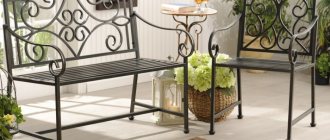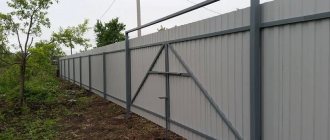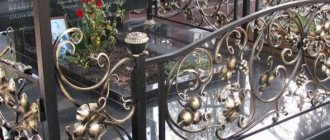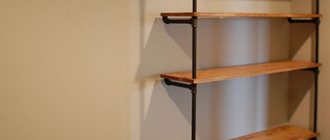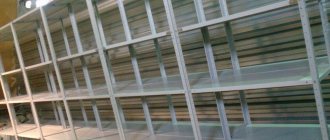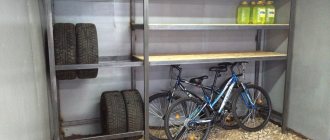Today, one of the areas of self-production of metal structures is the use of profile pipes. And if round pipe is used in most cases for laying pipelines, and sometimes for constructing frames and racks, then profile pipe today is a material with a much wider range of applications.
In this article we will look at the most significant aspects of the use of this material, as well as the most common homemade products from a profile pipe.
Pipes of different profiles
Profile pipe
General information about profile pipes
The term “profile pipe” most often refers to a pipe having a cross-section other than round.
The most common profile pipes have the following cross-section:
Most often, the profile pipe is made from carbon or low-alloy steel (grades St3SP, 09G2S or similar). Stainless steel pipes are also available. Aluminum profile pipe can be placed in a separate category - the use of this material differs from the use of steel pipes.
Profile pipe production
Profile pipes are produced by hot or cold deformation of a round pipe blank.
- From the workpiece (the so-called “strip”), a round welded pipe of the required diameter is made by bending and welding (determined by the calculation method).
- The round pipe blank is fed into a forming machine, where it is deformed to the required shape and cross-section.
- To relieve mechanical stress, the pipe (now we can talk about a profile pipe!) is subjected to heat treatment, followed by mandatory inspection of the weld.
Thanks to the formation of stiffening ribs on the pipe, products made from a profile pipe are quite strong - their metal frame can withstand loads many times greater than a frame made from a round pipe of a similar configuration.
Frame
To create a unique frame for framing a mirror, painting or portrait you will need:
- Tubes of different diameters;
- Cardboard or thick paper;
- Glue;
- Jigsaw.
Work process:
- Trace an outline on cardboard (for example, a mirror) and remove it;
- Cut the required number of pieces from the pipes;
- By arranging them in a certain order, form a beautiful frame;
- Glue the elements together;
- Let the frame dry for about a day.
Application of profile pipe
Profile pipe in industry
The widespread industrial use of profile pipes has become one of the factors that ensured the popularity of this material.
The most popular in industry are profile pipes 200x200 mm and 150x150 mm - various load-bearing structures are most often erected from such pipes, and the connection of profile pipes is made by welding.
Profile pipes of the specified section with a wall thickness of 6-12 mm provide the structure with strength equal to the strength of reinforced concrete load-bearing trusses.
At the same time, the economic effect of using a profile pipe is quite noticeable!
Canopy frame made of profile pipes
In industry, smaller profile pipes are also used - the use of such pipes is allowed when constructing frames that do not experience significant loads. For example, a 120x120 or 100x100 pipe is acceptable for the construction of warehouse-type structures, change houses, etc.
Read also: Scale on metal photo
DIY products from profile pipes
Along with very wide industrial use, today profile pipes are very actively used in private construction.
What can be made from a profile pipe? - Yes, almost anything!
Gazebo on a pipe frame
Profile pipes with a cross-section smaller than that used in industrial construction (for example, 100x50, 80x80 mm, etc.) are used for the construction of small architectural forms. Frames for country houses, domestic and outbuildings, pavilions, kiosks, advertising media, etc. are made from profile pipes.
In addition, fences and gates made from profile pipes have recently become quite popular. Indeed, it is much easier to dig columns of pipes of the appropriate size into the ground than to install concrete pillars or pedestals of appropriate size and strength.
Also, profile pipes can (naturally, with certain precautions) be used as a frame for frame-type residential buildings.
The advantages of using profile pipes for such tasks are obvious:
- With a profile pipe wall thickness of 4-8 mm (the most common parameters), the weight of a linear meter is 12-15 kg. This weight allows you to manipulate frame fragments without the involvement of heavy equipment, which is important if you are building structures from profile pipes on your own.
- Installation of profile pipes, both detachable (using brackets and couplings) and one-piece methods, is quite simple.
- The service life of such a frame is estimated in decades, and with proper protection from moisture, the structure turns out to be almost eternal.
Profile pipes with a cross section of 50x50 and 40x60 mm are widely used for internal frame structures: as frames for workbenches and small machines, for the manufacture of racks, shelves, display cases, trade and exhibition equipment, as well as furniture.
Due to the fact that such furniture made from profile pipes does not experience extremely high mechanical loads, thin-walled pipes (2-4 mm) are used for its manufacture. As a result, the structure itself, as a rule, has little mass.
To produce furniture from profile pipes (most often this is furniture for common areas, such as benches, desks and chairs for educational institutions), a profile pipe with a cross section of 40x25 or 20x20 mm is used. The wall thickness of such a pipe is 1-2 mm, which makes the furniture quite light with high strength values.
A profile pipe made of thin metal (0.8 - 1.5 mm) can be easily processed using a blowtorch.
With a sufficiently low level of heating, you can give such a pipe any shape you need.
That's why profile pipes are so valued by metal craftsmen!
Bed made of profile pipes
Aluminum profile pipes are also widely used for the manufacture of furniture and interior items. Despite the somewhat higher cost, its anti-corrosion properties make aluminum profile pipes very popular.
As you can see, the number of situations in which the use of a profile pipe will be justified is almost innumerable. That's why we strongly recommend that all craftsmen keep this wonderful, inexpensive and practical material in mind. And it’s quite possible that the acquired skill of working with profile pipes will come in handy!
Read also: How to make light music on a speaker
Openwork partition
Based on the principle of making a frame, you can build an interior partition that will divide the room into certain zones.
Pipe elements will need a large diameter; they can also serve as shelves where you can place beautiful souvenirs, figurines and other little things of aesthetic appearance.
General information about the profile pipe
The profile pipe can be made with a rectangular, oval, or square cross-section. As a rule, the material for its production is carbon or low-alloy steel. Stainless steel is less commonly used for these purposes.
Since profile pipes have stiffening ribs, they, like the products made from them, are characterized by increased strength. The resistance of such a metal frame to mechanical loads is much higher than that of a frame made from standard round pipes.
Profile pipes are convenient to store and transport. Pipes with a parallelepiped cross-section take up less space when stored and are more secure than pipes in the form of a cylinder.
Manege
The design may contain many elements, so first of all you need to sketch out a diagram of the future arena with all dimensions. Following the plans, calculate the required amount of material. In addition to the pipes you will need:
- Solid foundation;
- Rods
- Connectors, both straight and angled;
- Other elements, depending on the design itself.
Particular attention should be paid to the distance between the bars so that the child cannot slip out of a safe place and visibility zone.
Necessary tools for working with corrugated pipe
To cut the workpieces, you should use a circular saw - an angle grinder; a hand saw is also suitable. The parts are connected using a welding machine, but those who do not have one or are not skilled enough in handling one can take an electric drill and a set of drills for metal and wood. Also, to work with a profile pipe, you need to prepare a hammer, tape measure, chisel, screwdriver - or an electric screwdriver and a set of attachments, emery cloth.
Those who plan to create a structure with rounded elements are recommended to use a tool such as a profile pipe bender.
Shoe shelf
If there are pipe elements remaining from the installation of communications with a diameter of at least 150 mm, then you can create a convenient design for shoes. You only need:
- Cut pipe elements about 30cm in length;
- Pick up the base and secure the fragments glued together on it;
- Install near a wall or in another suitable place.
The dimensions of the product depend on the number of pairs of shoes and the area of the room. Each cell of this diameter and length will freely fit a pair of shoes.
Options for the use and application of profile pipes
Now we will look at a number of examples of the use of profile pipes for various structures.
Manufacturing furniture from profile pipes
In the design and production of furniture, the key property of profile pipes is versatility. This material is great for shelves, benches, coffee tables, hangers, open kitchens and desks.
To make furniture from metal elements, you need to follow the following step-by-step instructions: 1) study the drawing of a piece of furniture, cut the profile pipe into parts for blanks; 2) cleaning the cut burrs and drilling the necessary holes; 3) bending of frame structural elements using a tool; 4) welding work to connect structural parts; 5) tie the structure using bolts; 6) preparation and installation of fittings on furniture; 7) installation of wooden and plastic structural elements; painting furniture parts.
Greenhouse frame made of profile pipe
Self-construction of a greenhouse frame from profile pipes requires a certain amount of time, money and effort, but such a structure will last for many years and, as a result, will constantly bring benefits. When planning the construction of a greenhouse, the question of choosing frame material often arises. In this case, a profile pipe is one of the best solutions. The manufacture of a greenhouse, the frame of which is made of corrugated pipe, is described here.
Steel profile pipes for greenhouses are advantageous because different types of coverings, in particular polycarbonate, can be easily attached to them.
Read also: Electrical resistivity of the material
Gazebo made of profile pipe
To build a gazebo, a steel pipe with a square or rectangular cross-section is often used. The combination of the strength of the material and the rigidity of the pipes due to their shape ensures uniform distribution of the load on the gazebo, while at the same time the design is lightweight. With this profile, the required dimensions of the gazebo can be easily adjusted, which also has a neat and stylish design.
A gazebo made of profile pipes has many positive characteristics. The main ones are: • lightness of construction due to the absence of a massive base; • stability and long service life; • relatively low cash costs for the material; • fire resistance; • no need to carry out repairs from time to time.
Canopy made of profile pipe
Those who have a private house or just a plot outside the city often think about building a canopy. In addition, canopies made from profile pipes are often found in commercial organizations and public places, such as outdoor cafes, parking lots, recreation and entertainment areas. The main advantage of such canopies is their ease of manufacture - they are quite capable of being made independently. This task does not require special skills or knowledge, you just need to do everything according to the instructions. How to make a carport is described here.
View Queue
Queue
- delete everything
- Disable
Swing
It is recommended to make such a design from reinforced plastic pipes, since everything here is related to the safety of the child. Also, when working, you need to pay attention to every detail.
You need to act only if you are confident in the strength and correctness of each connection. You also need to take into account the weight of children who may be using this “attraction”.
If everything is done correctly, the result is a very beautiful, neat and useful structure for children. It is better to use schemes developed by professionals.
Advantages of making flower stands with your own hands: tips for different design options
The advantages of homemade flower stands include the following factors:
- Facilities. Materials for manufacturing can be easily found in the garage or storage room, and if something is missing, buy more at the nearest hardware store.
- Original design. Since in this work the person is his own designer, the work will be unique. Perhaps this was a talent that had been hidden for years.
- Quality of material. The person himself chooses every detail from which the structure will be made.
- Interior decoration. The main advantage and, at the same time, the main purpose of a wooden or metal flower stand is to decorate a house, apartment or yard.
Of course, the most important advantage of a homemade design is the opportunity to gain experience working with your hands. There is nothing wrong with taking the time to make a pedestal that has such a long list of advantages.
Please repost
0
